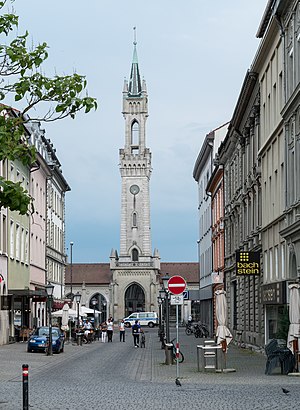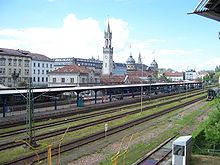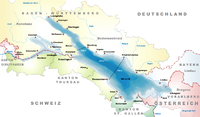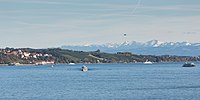Konstanz station

 Entrance building from the street | ||||||||||||||||||||||||||||||||||||||||||||||||||||||||||||||||||||||||||
| General information | ||||||||||||||||||||||||||||||||||||||||||||||||||||||||||||||||||||||||||
| Location | Bahnhofsplatz 43 Konstanz, Baden-Württemberg Germany | |||||||||||||||||||||||||||||||||||||||||||||||||||||||||||||||||||||||||
| Coordinates | 47°39′31.514″N 9°10′38.323″E / 47.65875389°N 9.17731194°E | |||||||||||||||||||||||||||||||||||||||||||||||||||||||||||||||||||||||||
| Owned by | DB Netz | |||||||||||||||||||||||||||||||||||||||||||||||||||||||||||||||||||||||||
| Operated by | DB Station&Service | |||||||||||||||||||||||||||||||||||||||||||||||||||||||||||||||||||||||||
| Line(s) | ||||||||||||||||||||||||||||||||||||||||||||||||||||||||||||||||||||||||||
| Platforms | ||||||||||||||||||||||||||||||||||||||||||||||||||||||||||||||||||||||||||
| Tracks | 3 | |||||||||||||||||||||||||||||||||||||||||||||||||||||||||||||||||||||||||
| Train operators | ||||||||||||||||||||||||||||||||||||||||||||||||||||||||||||||||||||||||||
| Construction | ||||||||||||||||||||||||||||||||||||||||||||||||||||||||||||||||||||||||||
| Architect | H. Leonhardt | |||||||||||||||||||||||||||||||||||||||||||||||||||||||||||||||||||||||||
| Architectural style | Gothic and Renaissance | |||||||||||||||||||||||||||||||||||||||||||||||||||||||||||||||||||||||||
| Other information | ||||||||||||||||||||||||||||||||||||||||||||||||||||||||||||||||||||||||||
| Station code | 3363[1] | |||||||||||||||||||||||||||||||||||||||||||||||||||||||||||||||||||||||||
| DS100 code | RKO[2] | |||||||||||||||||||||||||||||||||||||||||||||||||||||||||||||||||||||||||
| IBNR | 8003400 | |||||||||||||||||||||||||||||||||||||||||||||||||||||||||||||||||||||||||
| Category | 3[1] | |||||||||||||||||||||||||||||||||||||||||||||||||||||||||||||||||||||||||
| Fare zone | VHB: 5[3] | |||||||||||||||||||||||||||||||||||||||||||||||||||||||||||||||||||||||||
| Website | www.bahnhof.de | |||||||||||||||||||||||||||||||||||||||||||||||||||||||||||||||||||||||||
| History | ||||||||||||||||||||||||||||||||||||||||||||||||||||||||||||||||||||||||||
| Opened | 1863 | |||||||||||||||||||||||||||||||||||||||||||||||||||||||||||||||||||||||||
| ||||||||||||||||||||||||||||||||||||||||||||||||||||||||||||||||||||||||||
| ||||||||||||||||||||||||||||||||||||||||||||||||||||||||||||||||||||||||||
Konstanz station (German: Bahnhof Konstanz) is the largest passenger station in the German city of Konstanz (Constance). It is served by regional and long-distance services operated by Deutsche Bahn and Swiss Federal Railways. It is the end of the High Rhine Railway and the beginning of the Lake Line.
History
[edit]The station was opened to traffic 15 June 1863 with the opening of the last section of the Upper Rhine Railway between Waldshut and Konstanz by the Grand Duchy of Baden State Railway. The link to Switzerland was opened in 1871, when the Swiss Northeastern Railway (German: Schweizerische Nordostbahn, NOB) opened the line between Romanshorn and Konstanz, now part of the Seelinie ("Lake line"). On 17 July 1875 this was followed by the building of the Etzwilen–Konstanz line, together with the Kreuzlingen–Kreuzlingen harbour connecting line, by the Swiss National Railway (Schweizerische Nationalbahn, SNB).[4] After the SNB went bankrupt in 1878, its tracks were taken over by the NOB. In 1902, the NOB was absorbed in the newly created SBB.
In 1911, the Mittelthurgau-Bahn (MThB) opened a line from Kreuzlingen via Berg and Weinfelden to Wil. From the beginning, services from Kreuzlingen ran on the former SBB line through Konstanz to connect with the German rail network. It was served by the S-Bahn-like Seehas (named after a mythical "lake hare") service developed by the MThB over the Upper Rhine Railway to Engen. In 2002, the MThB fell into financial difficulties and was subsequently liquidated. Since then, subsidiaries of SBB have operated its services: SBB GmbH between Konstanz and Engen and THURBO between Konstanz and Weinfelden/Wil.
Architecture
[edit]The station is located on the shore. The station building was built in 1863 in Gothic and Renaissance styles, modelled on the Palazzo Vecchio in Florence. North of the entrance building was the Fürstenbahnhof ("princes’ station building"), a pavilion, which now serves as a shopping centre.
The station has three tracks: a “home” platform (next to the entrance building) and a central island platform. To reach the central platform, tracks 2 and 1 must be crossed on the level. This crossing is protected by a barrier. At the northern end, there is also a tunnel that connects the platforms on one side to the city centre and on the other side to the port. In addition, there are two walkways and a shopping centre leading to the lake.
Structural condition
[edit]In the past, Konstanz had a reputation as a "grubby" station, as it was rundown and inefficient.[5] The last major work on the station had been the renovation of the bell tower carried out between 1975 and 1983. As part of the economic stimulus program the entrance building is being rehabilitated with energy-saving measures. The waiting area is also being made more attractive.
Border station
[edit]Konstanz has the function of a border station. Before November 2008, when Switzerland became a party to the Schengen Agreement, the central platform was separated by a chain-link fence. Long-distance trains to and from Switzerland stopped on platform 3. The station building also has two sections for the German and Swiss railways. The German part is still operated by Deutsche Bahn and the Swiss part by Thurbo (formerly Mittelthurgaubahn). Until 2008 travellers to the Swiss section of the station had to pass through a form of passport control to get to the platforms. The station remains a customs border and as such customs checks are still possible by the authorities of both countries.
Traffic
[edit]Long-distance
[edit]Deutsche Bahn
[edit]

Deutsche Bahn operates only a few long-distance trains from Konstanz. A daily InterCity train running to/from Hamburg, extended in the summer months to/from Stralsund, was discontinued in December 2014. Since then, there is only one InterCity runs from Emden via Cologne: Friday and Saturday to Constance, Saturday and Sunday in the opposite direction.
| Line | Route | Frequency |
|---|---|---|
| ICE 26 | Hamburg-Altona – Lüneburg – Hanover – Göttingen – Gießen – Frankfurt (Main) Hauptbahnhof – Offenburg – Villingen (Schwarzw) - Singen(Hohentwiel) – Radolfzell – Konstanz | Some trains on the weekend in the Summer |
| IC 35 | Emden Hbf – Münster – Duisburg – Cologne – Bonn – Koblenz – Mannheim – Karlsruhe – Offenburg – Konstanz | One train pair each weekend |
| IC 87 | Stuttgart – Böblingen – Herrenberg – Horb – Rottweil – Tuttlingen – Singen – Radolfzell – Konstanz | Two train pairs |
SBB
[edit]Swiss Federal Railways (SBB) InterRegio trains run hourly from Lucerne to Konstanz:[6]
 Lucerne – Zug – Zürich HB – Zürich Airport – Winterthur – Frauenfeld – Weinfelden – Kreuzlingen – Konstanz
Lucerne – Zug – Zürich HB – Zürich Airport – Winterthur – Frauenfeld – Weinfelden – Kreuzlingen – Konstanz
Regional transport
[edit]Deutsche Bahn
[edit]Konstanz is served hourly by Regional-Express (RE) trains on the Black Forest Railway. Until the timetable change in 2015, Interregio-Express and RE trains alternated from Kreuzlingen or Konstanz to Karlsruhe. This was changed with the timetable change, so that there is now a continuous RE hourly to Karlsruhe.
- RE 2 Karlsruhe – Baden-Baden – Offenburg – Villingen – Donaueschingen – Singen – Konstanz
SBB
[edit]The Swiss Federal Railways (SBB) and its subsidiary SBB GmbH, which has its head office in Konstanz, serves Konstanz with the named train Seehas, a regional service operating every half hour. Its subsidiary THURBO connects Konstanz and Kreuzlingen every half hour with the St. Gallen S-Bahn S14 service, which calls at every station upon request, and the S44, which does not call at stations between Kreuzlingen and Weinfelden.[6] These regional services form part of a wider network around Lake Constance, marketed as the Bodensee S-Bahn, spreading over four countries (Germany, Switzerland, Austria, Liechtenstein).[7]
- S6: Konstanz – Radolfzell – Singen – Engen (Seehas; SBB GmbH)
- S14: Konstanz – Kreuzlingen – Berg – Weinfelden (THURBO)
- S44: Konstanz – Kreuzlingen – Weinfelden (THURBO)
- RE1: Konstanz – Kreuzlingen Hafen – Romanshorn – St. Gallen – Herisau (THURBO)
The RegioExpress (RE1) from Konstanz via St. Gallen to Herisau with stops in Kreuzlingen Hafen and Romanshorn was introduced in December 2015 after lengthy negotiations. At first there are five trains per day and direction. The project almost failed for lack of funding, although the Kreuzlingen/Konstanz-Romanshorn-St. Gallen railway line has been comprehensively refurbished in recent years for this express service. GTW sets of Stadler Rail operated by THURBO are used. The same trainsets are used for RE1 and the S14, meaning that passengers do not have to change trains in Konstanz.
Other public transport
[edit]The bus stop at the station is served by city bus lines 1, 2, 3, 6, 908, 9A/B, 12, 4/13, 13/4 and 14. The nearby Marktstätte bus stop is served by lines 5, 6 and 908 (towards Landschlacht). Regional bus services are operated by the express buses of the RAB to Ravensburg and Friedrichshafen. Some buses of the SBG operate to Allensbach and Radolfzell. Catamaran services also run every hour to Friedrichshafen from the port near the station.
References
[edit]- ^ a b "Stationspreisliste 2024" [Station price list 2024] (PDF) (in German). DB Station&Service. 24 April 2023. Retrieved 29 November 2023.
- ^ Eisenbahnatlas Deutschland [German railway atlas] (in German) (Updated ed.). Cologne: Schweers + Wall. 2020. p. 112. ISBN 978-3-89494-149-9.
- ^ "Tarife Preise Zonen 2024" (PDF). Verkehrsverbund Hegau-Bodensee. Retrieved 3 August 2024.
- ^ "Schienennetz Schweiz [Railway network of Switzerland]" (PDF) (in German). Bern: Swiss Federal Railways (SBB). 2023.
- ^ "Konstanzer Schmuddelbahnhof nach dem Vorbild des "Pallazzo Vecchio" gebaut". Bodensee-Woche (in German). Archived from the original on 1 January 2010. Retrieved 10 May 2011.
- ^ a b "Konstanz–Weinfelden" (PDF). Bundesamt für Verkehr. 11 November 2019. Retrieved 27 December 2019.
- ^ "Fahrplan-Netzkarte 2024 [Railway network Lake Constance 2024]" (PDF) (in German). THURBO. 2023-12-10. Retrieved 2023-12-18.



